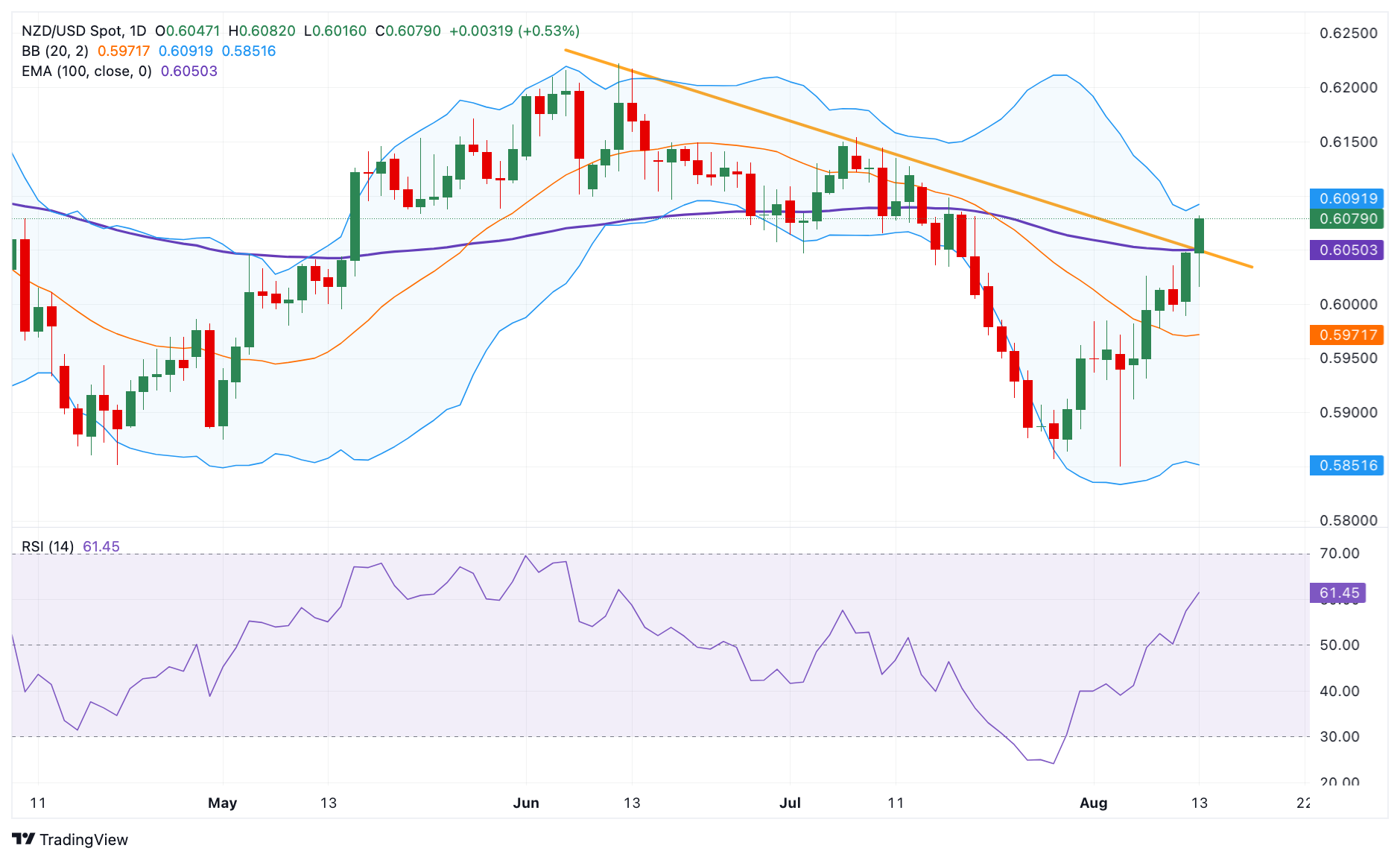New Zealand Dollar faces some selling pressure after RBNZ surprises rate cut to 5.25%

- The New Zealand Dollar (NZD) loses momentum in Wednesday’s Asian session.
- The RBNZ cut its Official Cash Rate to 5.25% at its August meeting on Wednesday.
- Market participants await the US July CPI inflation data, which is due later on Wednesday.
The New Zealand Dollar (NZD) edges lower despite the weaker Greenback on Wednesday. After the August policy meeting conducted on Wednesday, the Reserve Bank of New Zealand (RBNZ) board members decided to cut its Official Cash Rate (OCR) steady by 25 basis points (bps) from 5.50% to 5.25%. The market participants expected a rates on-hold decision. The Kiwi attracts some sellers in an immediate reaction to the RBNZ surprise dovish move. The markets are now pricing in another rate cuts at its next policy meeting on October 9.
Meanwhile, further optimism in the risk sentiment has maintained the US Dollar (USD) under pressure in the previous sessions and created a tailwind for the pair. The signs of stronger demand from China also underpin the Kiwi as China is New Zealand’s largest trading partner.
Later in the day, the attention will shift to the release of theUS July Consumer Price Index (CPI). The CPI is projected to increase 0.2% MoM in July, compared to a 0.1% decline in the previous month. On an annual basis, the CPI inflation is forecasted to ease to 2.9% in July from 3.0% in June.
Daily Digest Market Movers: New Zealand Dollar weakens after RBNZ surprises rate cut
- According to the Minutes of the RBNZ interest rate meeting, board members agreed that policy will need to remain restrictive for some time to ensure that domestic inflationary pressures continue to decline.
- RBNZ Governor Adrian Orr said during the press conference that he is confident inflation back in its target band can commence re-normalize rates. Orr further stated that the central bank considered a range of moves, the consensus was for 25 bps.
- New Zealand central bank’s new forecast suggested the OCR will fall from here to at least 5% by the end of the year and to at least 4.5% by June next year.
- The US Producer Price Index (PPI) for final demand in the US rose 2.2% YoY in July from 2.7% in June, the Bureau of Labor Statistics showed Tuesday. This figure was below the market expectation of 2.3%. On a monthly basis, the PPI increased 0.1% MoM in the same period after rising by an unrevised 0.2% in June.
- The annual core PPI came in softer than expected, rising by 2.4% in July but falling short of an estimate of 2.7%. On a monthly basis, the core PPI remained unchanged.
- Investors expect a 25 basis point (bps) rate cut in September, followed by similar reductions in November and December. A 50 bps cut in September is possible but depends entirely on the data.
- Atlanta Fed President Raphael Bostic said on Tuesday that recent economic data made him “more confident” that the Fed can get inflation back to its 2% target. Still, more evidence is needed before he’s ready to support lowering interest rates, per Reuters.
Technical Analysis: New Zealand Dollar resumes bullish bias
The New Zealand Dollar trades on a weaker note on the day. However, the NZD/USD pair has resumed its uptrend since the price crossed above the key 100-day Exponential Moving Average (EMA) and broke above the descending trendline on the daily chart. The 14-day Relative Strength Index (RSI) is above the midline near 61.00, suggesting that upside momentum is present and the support level is likely to hold rather than break.
The immediate resistance level for NZD/USD emerges at the 0.6090-0.6100 region, portraying the upper boundary of the Bollinger Band and psychological mark. A decisive break above this level could potentially take the price to 0.6154, a high of July 8.
On the other hand, the resistance-turned-support level at 0.6050 acts as an initial support level for the pair. Any follow-through selling below the mentioned level would expose 0.5977, a low of August 8.
New Zealand Dollar price in the last 7 days
The table below shows the percentage change of New Zealand Dollar (NZD) against listed major currencies in the last 7 days. New Zealand Dollar was the weakest against the Australian Dollar.
| USD | EUR | GBP | CAD | AUD | JPY | NZD | CHF | |
| USD | -0.61% | -1.35% | -0.51% | -1.72% | 1.23% | -0.78% | 1.37% | |
| EUR | 0.60% | -0.75% | 0.10% | -1.11% | 1.80% | -0.17% | 1.97% | |
| GBP | 1.35% | 0.74% | 0.84% | -0.36% | 2.52% | 0.56% | 2.69% | |
| CAD | 0.51% | -0.09% | -0.86% | -1.20% | 1.70% | -0.29% | 1.87% | |
| AUD | 1.70% | 1.10% | 0.35% | 1.19% | 2.90% | 0.91% | 3.06% | |
| JPY | -1.21% | -1.79% | -2.57% | -1.69% | -2.93% | -1.96% | 0.19% | |
| NZD | 0.80% | 0.17% | -0.59% | 0.27% | -0.94% | 1.96% | 2.14% | |
| CHF | -1.38% | -2.01% | -2.76% | -1.90% | -3.13% | -0.17% | -2.19% |
The heat map shows percentage changes of major currencies against each other. The base currency is picked from the left column, while the quote currency is picked from the top row. For example, if you pick the Euro from the left column and move along the horizontal line to the Japanese Yen, the percentage change displayed in the box will represent EUR (base)/JPY (quote).
RBNZ FAQs
The Reserve Bank of New Zealand (RBNZ) is the country’s central bank. Its economic objectives are achieving and maintaining price stability – achieved when inflation, measured by the Consumer Price Index (CPI), falls within the band of between 1% and 3% – and supporting maximum sustainable employment.
The Reserve Bank of New Zealand’s (RBNZ) Monetary Policy Committee (MPC) decides the appropriate level of the Official Cash Rate (OCR) according to its objectives. When inflation is above target, the bank will attempt to tame it by raising its key OCR, making it more expensive for households and businesses to borrow money and thus cooling the economy. Higher interest rates are generally positive for the New Zealand Dollar (NZD) as they lead to higher yields, making the country a more attractive place for investors. On the contrary, lower interest rates tend to weaken NZD.
Employment is important for the Reserve Bank of New Zealand (RBNZ) because a tight labor market can fuel inflation. The RBNZ’s goal of “maximum sustainable employment” is defined as the highest use of labor resources that can be sustained over time without creating an acceleration in inflation. “When employment is at its maximum sustainable level, there will be low and stable inflation. However, if employment is above the maximum sustainable level for too long, it will eventually cause prices to rise more and more quickly, requiring the MPC to raise interest rates to keep inflation under control,” the bank says.
In extreme situations, the Reserve Bank of New Zealand (RBNZ) can enact a monetary policy tool called Quantitative Easing. QE is the process by which the RBNZ prints local currency and uses it to buy assets – usually government or corporate bonds – from banks and other financial institutions with the aim to increase the domestic money supply and spur economic activity. QE usually results in a weaker New Zealand Dollar (NZD). QE is a last resort when simply lowering interest rates is unlikely to achieve the objectives of the central bank. The RBNZ used it during the Covid-19 pandemic.
Information on these pages contains forward-looking statements that involve risks and uncertainties. Markets and instruments profiled on this page are for informational purposes only and should not in any way come across as a recommendation to buy or sell in these assets. You should do your own thorough research before making any investment decisions. FXStreet does not in any way guarantee that this information is free from mistakes, errors, or material misstatements. It also does not guarantee that this information is of a timely nature. Investing in Open Markets involves a great deal of risk, including the loss of all or a portion of your investment, as well as emotional distress. All risks, losses and costs associated with investing, including total loss of principal, are your responsibility. The views and opinions expressed in this article are those of the authors and do not necessarily reflect the official policy or position of FXStreet nor its advertisers. The author will not be held responsible for information that is found at the end of links posted on this page.
If not otherwise explicitly mentioned in the body of the article, at the time of writing, the author has no position in any stock mentioned in this article and no business relationship with any company mentioned. The author has not received compensation for writing this article, other than from FXStreet.
FXStreet and the author do not provide personalized recommendations. The author makes no representations as to the accuracy, completeness, or suitability of this information. FXStreet and the author will not be liable for any errors, omissions or any losses, injuries or damages arising from this information and its display or use. Errors and omissions excepted.
The author and FXStreet are not registered investment advisors and nothing in this article is intended to be investment advice.




